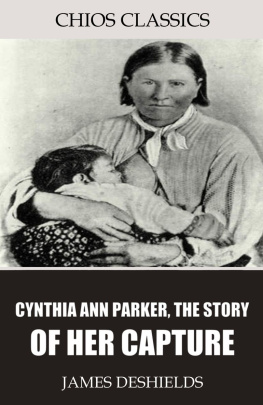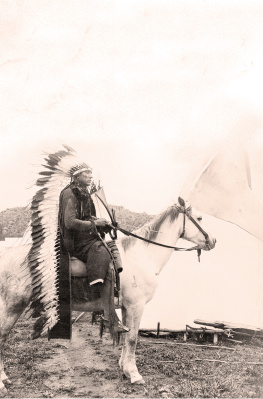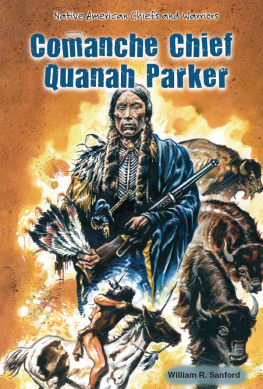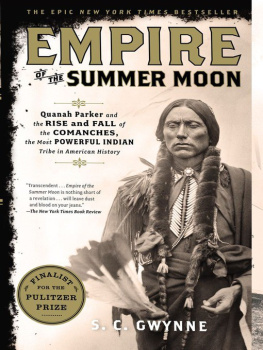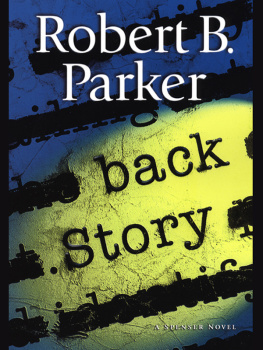James DeShields - Cynthia Ann Parker, the Story of Her Capture
Here you can read online James DeShields - Cynthia Ann Parker, the Story of Her Capture full text of the book (entire story) in english for free. Download pdf and epub, get meaning, cover and reviews about this ebook. year: 2018, publisher: Charles River Editors, genre: Non-fiction. Description of the work, (preface) as well as reviews are available. Best literature library LitArk.com created for fans of good reading and offers a wide selection of genres:
Romance novel
Science fiction
Adventure
Detective
Science
History
Home and family
Prose
Art
Politics
Computer
Non-fiction
Religion
Business
Children
Humor
Choose a favorite category and find really read worthwhile books. Enjoy immersion in the world of imagination, feel the emotions of the characters or learn something new for yourself, make an fascinating discovery.
- Book:Cynthia Ann Parker, the Story of Her Capture
- Author:
- Publisher:Charles River Editors
- Genre:
- Year:2018
- Rating:5 / 5
- Favourites:Add to favourites
- Your mark:
- 100
- 1
- 2
- 3
- 4
- 5
Cynthia Ann Parker, the Story of Her Capture: summary, description and annotation
We offer to read an annotation, description, summary or preface (depends on what the author of the book "Cynthia Ann Parker, the Story of Her Capture" wrote himself). If you haven't found the necessary information about the book — write in the comments, we will try to find it.
Chios Classics brings literatures greatest works back to life for new generations. All our books contain a linked table of contents.
Cynthia Ann Parker, the Story of Her Capture tells the story of the famous settler who was capture by a Comanche war band as a young child.
Cynthia Ann Parker, the Story of Her Capture — read online for free the complete book (whole text) full work
Below is the text of the book, divided by pages. System saving the place of the last page read, allows you to conveniently read the book "Cynthia Ann Parker, the Story of Her Capture" online for free, without having to search again every time where you left off. Put a bookmark, and you can go to the page where you finished reading at any time.
Font size:
Interval:
Bookmark:
Cynthia Ann Parker, the Story of Her Capture
By James DeShields
THE STORY OF HER CAPTURE
At the Massacre of the Inmates of Parkers Fort; of her Quarter of a Century Spent Among the Comanches, as the Wife of the War Chief, Peta Nocona; and of her Recapture at the Battle of Pease River, by Captain L. S. Ross, of the Texian Rangers.
by
JAMES T. DeSHIELDS,
Author of Frontier Sketches, Etc.
Truth is Stranger than Fiction.
(By Permission)
TO
GENL. L. S. ROSS,
OF
WACO, TEXAS.
PREFACE
In the month of June, 1884, there appeared in the columns of the Forth Worth Gazette an advertisement signed by the Comanche chief, Quanah Parker, and dated from the reservation near Fort Sill, in the Indian Territory, enquiring for a photograph of his late mother, Cynthia Ann Parker, which served to revive interest in a tragedy which has always been enveloped in a greater degree of mournful romance and pathos than any of the soul-stirring episodes of our pioneer life, so fruitful of incidents of an adventurous nature.
From the valued narratives kindly furnished us by Victor M. Ross, Major John Henry Brown and Gen. L. S. Ross, supplemented by the Jas. W. Parker book and copious notes from Hon. Ben. F. Parker, together with most of the numerous partial accounts of the fall of Parkers Fort and subsequent relative events, published during the past fifty years; and after a careful investigation and study of the whole, we have laboriously and with much pains-taking, sifted out and evolved the foregoing narrative of plain, unvarnished facts, which form a part of the romantic history of Texas.
In the preparation of our little volume the thanks of the youthful author are due to Gen. L. S. Ross, of Waco; Major John Henry Brown of Dallas; Gen. Walter P. Lane of Marshall; Col. John S. Ford of San Antonio; Rev. Homer S. Thrallthe eminent historian of Texas; Mr. A. F. Corning of Waco; Capt. Lee Hall, Indian Agent, I. T., and Mrs. C. A. West-brook of Lorena, for valuable assistance rendered.
To Victor M. Ross of Laredo, Texas, the author has been placed under many and lasting obligations for valuable data so generously placed at his disposal, and that too at considerable sacrifice to the donor.
From this source we have obtained much of the matter for our narrative.
In submitting our little workthe first efforts of the youthful authorwe assure the reader that while there are, doubtless, many defects and imperfections, he is not reading fiction, but facts which form only a part of the tragic and romantic history of the Lone Star State.
JAMES T. DeSHIELDS,
Belton, Texas, May 19, 1886.
CYNTHIA ANN PARKER.
CHAPTER I.The Parker Fort Massacre, Etc.
Contemporary with, and among the earliest of the daring and hardy pioneers that penetrated the eastern portion of the Mexican province of Texas, were the Parker family, who immigrated from Cole county, Illinois, in the fall of the year 1833, settling on the west side of the Navasota creek, near the site of the present town of Groesbeck, in Limestone county, one or two of the family coming a little earlier and some a little later.
The elder John Parker was a native of Virginia, resided for a time in Elbert county, Georgia, but chiefly reared his family in Bedford county, Tennessee, whence in 1818 he removed to Illinois.
The family, with perhaps one or two exceptions, belonged to one branch of the primitive Baptist church, commonly designated as two seed, or hard shell Baptists.
In the spring of 1834 the colonist erected Parkers Fort, a kind of wooden barricade, or wall around their cabins, which served as a means of better protecting themselves against the numerous predatory bands of Indians into that, then, sparsely settled section.
As early as 1829 the Prairie Indians had declared war against the settlers, and were now actively hostile, constantly committing depredations in different localities.
Parkers colony at this time consisted of only some eight or nine families, viz : Elder John Parker, patriarch of the family, and his wife; his son James W. Parker, wife, four single children and his daughter, Mrs. Rachel Plummer, her husband, L. M. T. Plummer, and infant son, fifteen months old; Mrs. Sarah Nixon, another daughter, and her husband L. D. Nixon; Silas M. Parker (another son of Elder John), his wife and four children; Benjamin F. Parker, an unmarried son of the Elder ); Mrs. Nixon, sr., mother of Mrs. James W. Parker; Mrs. Elizabeth
Kellogg, daughter of Mrs. Nixon; Mrs. Duty;
Samuel M. Frost, wife and two children; G. E. Dwight, wife and two children; in all thirty-four persons.
Besides those above mentioned, old man Lunn, David Faulkenberry and his son Evan, Silas Bates, and Abram Anglin, a boy, had erected cabins a mile or two distant from the fort, where they resided.
These families were truly the advance guard of civilization of that part of our frontier. Fort Houston, in Anderson county, being the nearest protection, except their own trusty rifles.
Here the struggling colonist remained, engaged in the avocations of a rural life, tilling the soil, hunting buffalo, bear, deer, turkeys and smaller game, which served abundantly to supply their larder at all times with fresh meat, in the enjoyment of a life of Arcadian simplicity, virtue and contentment, until the latter part of the year 1835, when the Indians and Mexicans forced the little band of compatriots to abandon their homes, and flee with many others before the invading army from Mexico.
On arriving at the Trinity river they were compelled to halt in consequence of an overflow. Before they could cross the swollen stream the sudden and unexpected news reached them that Santa Anna and his vandal hordes had been confronted and defeated at San Jacinto, that sanguinary engagement which gave birth to the new sovereignty of Texas, and that TEXAS WAS FREE FROM MEXICAN TYRANNY.
On receipt of this news the fleeing settlers were overjoyed, and at once returned to their abandoned homes.
The Parker colony now retraced their steps, first going to Fort Houston, where they remained a few days in order to procure supplies, after which they made their way back to Fort Parker to look after their stock and to prepare for a crop.
These hardy sons of toil spent their nights in the fort, repairing to their farms early each morning.
On the night of May 18, 1836, all slept at the fort, James W. Parker, Nixon and Plummer repairing to their field a mile distant on the Navasota, early next morning, little thinking of the great calamity that was soon to befall them.
About 9 oclock a. m. the fort was visited by several hundred Comanche and Kiowa Indians. On approaching to within about three hundred yards of the fort the Indians halted in the prairie, presenting a white flag; at the same time making signs of friendship.
At this time there were only six men in the fort, three having gone out to work in the field as above stated. Of the six men remaining, only five were able to bear arms, viz: Elder John Parker, Benjamin and Silas Parker, Samuel and Robert Frost. There were ten women and fifteen children.
The Indians, artfully feigning the treacherous semblance of friendship, pretented that they were looking for a suitable camping place, and enquired as to the exact
locality of a water-hole in the vicinity at the same time asking for a beef to appease their hungrya want always felt by an Indian, when the promise of fresh meat loomed up in the distant perspective; and he would make such pleas with all the servile sicophancy of a slave, like the Italian who embraces his victim ere plunging the poniard into his heart.
Not daring to resent so formidable a body of savages, or refuse to comply with their requests, Mr. Benjamin F. Parker went out to them, had a talk and returned, expressing the opinion that the Indians were hostile and intented to fight, but added that he would go back and try to avert it. His brother Silas remonstrated, but he persisted in going, and was immediately surrounded and killed, whereupon the whole forcetheir savage instincts aroused by the sight of bloodcharged upon the works, uttering the most terrific and unearthly yells that ever greeted the ears of mortals. Cries and confusion reigned. The sickening and bloody tragedy was soon enacted. Brave Silas M. Parker fell on the outside of the fort, while he was gallantly fighting to save Mrs. Plummer. Mrs. Plummer made a most manful resistance, but was soon overpowered, knocked clown with a hoe and made captive. Samuel M. Frost and his son Robert met their fate while heroically defending the women and children inside the stockade. Old Granny Parker was outraged, stabbed and left for dead. Elder John Parker, wife and Mrs. Kellogg attempted to make their escape, and in the effort had gone about three fourths of a mile, when they were overtaken and driven back near to the fort where the old gentleman was stripped, murdered, scalped and horribly mutilated. Mrs. Parker was stripped, speared and left for dead, but by feigning death escaped, as will be seen further on. Mrs. Kellogg was spared as a captive.
Font size:
Interval:
Bookmark:
Similar books «Cynthia Ann Parker, the Story of Her Capture»
Look at similar books to Cynthia Ann Parker, the Story of Her Capture. We have selected literature similar in name and meaning in the hope of providing readers with more options to find new, interesting, not yet read works.
Discussion, reviews of the book Cynthia Ann Parker, the Story of Her Capture and just readers' own opinions. Leave your comments, write what you think about the work, its meaning or the main characters. Specify what exactly you liked and what you didn't like, and why you think so.

